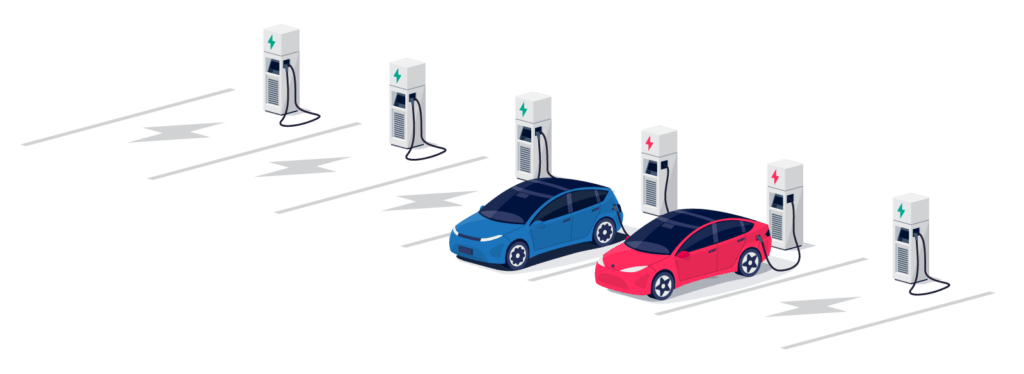Navigating the Vehicle-to-Grid Highway
As EV technologies have evolved over the years, the vision for their use and value to the grid has emerged as a viable concept, a solution to a problem that, until now, has been out of reach. Policymakers have begun to reimagine the EV as a grid resource beyond their role as a zero- or low-emissions mode of transportation. In fact, transportation electrification offers a bold new pathway to help states and the federal government reach their energy and climate targets. Electric Vehicles (EVs) not only reduce air pollution and greenhouse gas emissions but offer the promise of enhancing the operational efficiency of electric grids. This summary highlights the major points of discussion brought out in the Interstate Renewable Energy Council (IREC) white paper, Paving the Way: Vehicle-to-Grid (V2G) Standards for Electric Vehicles.
Bidirectional Power Flow
Conceptually, Vehicle-to-Grid (V2G) sees EVs as mobile energy storage units similar to stationary energy storage systems. Rather than drawing power from the grid, V2G allows EVs to communicate with and provide power and energy services to the grid via bidirectional (or reverse) power flow. This two-way power conduit helps even out fluctuations in energy demand support grid stability since EVs can charge during low demand periods and send power and energy to the grid when demand rises.
Tapping Into an Entirely New Grid Resource
Cumulatively, V2G offers a wealth of benefits. The Electric Power Research Institute revealed that V2G could provide $1 billion in annual grid benefits in California alone. The state need only reach its goal of five million EVs by 2030 if just half of those EVs are V2G-enabled to see this benefit. By providing grid services, such as voltage and frequency support along with peak shaving and load shifting, V2G-enabled EVs could offer states and utilities an entirely new grid resource — one that meets clean energy policy goals and provides ratepayer and system benefits while reducing the need for new central power plants. What’s more, EV adopters could derive new revenue streams from grid services their vehicles provide.
Three Inverter Systems
Before leapfrogging into V2G, grids must be set up to ensure that an EV can return power and other services to the grid. This grid-to-EV interaction may vary based on the charging infrastructure. Currently, three types of V2G configurations are under consideration. There’s V2G-DC, V2G-AC, and the V2G-Split Inverter. They differ in where the power conversion (done using an advanced inverter) and advanced inverter functions reside. The power conversion and smart functions can be housed solely within the EV charger (V2G-DC) or within the EV (V2G-AC). In the Split Inverter), the EV charger includes the smart functions with its corresponding power conversion located on-board the EV.
Standards Needed
The future is bright for V2G. But before V2G-enabled EV charging becomes a viable customer and grid asset, standardization to govern their interaction and communication with grid operations must be developed and adopted. These include protocols that govern communications between EVs and the customer, EVs and the EV charging equipment, and EV charging equipment and grid operators. Standards are integral to the safe and efficient integration of DERs (Distributed Energy Resources) on the electric grid. Therefore, regulators, utilities, and manufacturers must understand the various standards and protocols that can enable grid integration of the V2G charging infrastructure.
Applicable V2G standards remain in the early development stages and involve multiple organizations, such as UL, SAE, IEEE, SunSpec, Open Charge Alliance, Automated Demand Response (OpenADR) Alliance, and ISO. UL 1741 is widely used for grid interconnection and guides evaluating inverters with specific grid compliance requirements. UL 9741 covers bidirectional EVSE and applies to V2G-DC as well as V2G-AC systems. SAE J2836/3 is a broad information report (not a standard) that explains different approaches for using the energy of an EV battery to power remote loads (V2L). SAE J3072 is a new standard that specifies how EVs and charging stations should communicate in the V2G-AC configuration. And ISO 15118-20 is another new standard that covers V2G communications for both V2G-DC and AC between the EV and charging station.
These standards, which include specific communication protocols (also known as interoperability protocols), are a critical element of DER integration. These protocols provide an information exchange channel with DERs in a consistent manner. This exchange can apply to all DERs (such as inverters) or be specific to certain DER types (such as energy storage). IEEE 2030.5 is expected to have immediate impacts on DERs by establishing channels for communications between EVs and EVSE, between EVSE and energy management systems, and between EVSE and EV/DER aggregators and further up the architecture to the grid operator DER management systems.
Where we are today
While some states have begun to explore V2G, and V2G-enabled equipment is being developed and commercialized, Vehicle-to-Grid is still nascent in the U.S. To bring this technology to full fruition, several challenges must first be addressed. One initial hurdle is determining how to safely and cost-efficiently interconnect new V2G technologies (like mobile inverters) to the grid. Many state interconnection rules have not been updated to reflect the unique attributes of energy storage, whether mobile or stationary. Other V2G barriers and concerns include the high cost of V2G-enabled equipment, battery degradation and charging management, customer awareness and buy-in, value streams for grid services, and potential grid impacts.
